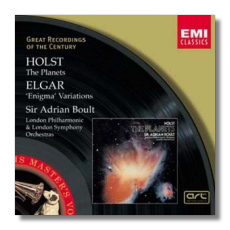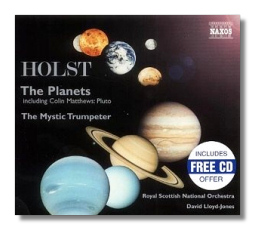
The Internet's Premier Classical Music Source
Related Links
- Latest Reviews
- More Reviews
-
By Composer
-
Collections
DVD & Blu-ray
Books
Concert Reviews
Articles/Interviews
Software
Audio
Search Amazon
Recommended Links
Site News
 CD Review
CD Review
The Planets

- Edward Elgar: Enigma Variations
- Gustav Holst: The Planets
London Symphony Orchestra/Adrian Boult
London Philharmonic Orchestra/Adrian Boult
EMI Great Recordings of the Century 67749


- Gustav Holst:
- The Planets
- The Mystic Trumpeter
- Colin Matthews: Pluto
Royal Scottish National Orchestra/David Lloyd-Jones
Naxos 8.555776
As Donald Satz puts it in reviews he posts on Classical.Net's forum: For the busy executive: Boult beats Lloyd-Jones in a first round knock out.
The particulars in this case will focus on two movements of The Planets, Mars and Saturn. Forget Pluto… it is like trying to fit a round peg into a square hole and you aren't going to purchase the disc for the Mystic Trumpeter. I will also refer to Stokowski's recordings of the Holst and Elgar in my review.
First let's deal with the issue of sound. Boult's EMI release has depth, resonance, detail and warmth. The Naxos release has none of these. True the woodwinds sound lovely, they always do in Naxos recordings. But the trumpet in its first appearance sounds anemic and doesn't have the dissonance you can hear from the LSO's player, which is important to the music. The anemia may due to the sound but the playing is either requested by the conductor or accepted.
The interpretations are also dramatically different (pun intended). Boult takes Mars at a significantly slower tempo: 7:57 to Lloyd-Jones' 7:03. A faster tempo is not necessarily a detriment to the effect, Stokowski (on EMI 67469, coupled with a fantastic recording of Schoenberg's Verklärte Nacht) takes 6:36 but Lloyd-Jones is simply faster that's all. The tension the other conductors bring to the music is slack in this Naxos release. The pause at the end of the first climax is crucial and Lloyd-Jones takes too long. Boult and particularly Stokowski time this just perfectly! Stokowski caps this "movement" with a resonant tam-tam that may not be in the score but it sure as hell adds to the effect! The tam-tam cannot be heard at all in the Naxos recording and while it is in Boult's it is not as dramatically brought to the fore. Finally, the organ can be clearly heard in the EMI release and, like so much else, is essentially or literally missing in the Lloyd-Jones recording.
For some reason I was thinking of Plato's allegory of the cave when I was listening to Saturn. In the allegory what is "known" is what we see on the walls of a cave we are looking at but we see only shadows. The real is behind us, and the shadows on the wall are thrown there by objects behind us, which we see because of the light behind them. We do not actually see reality, only its shadows. If we were to turn and walk out of the cave at first the light would blind us, but once our eyes adjust we would see reality. If we were then to return to the cave and tell our companions about the real world they would think us crazy because it is not what they perceive. As I listen to Saturn I can visualize looking at the shadows, then slowly turning and making the difficult scale to reality.
Boult's recording is what brought this vision to mind. Stokowski's is much faster (7:48 to 8:17) but still has the tension, the effort being made to reach out. Lloyd-Jones is lugubrious and takes over nine minutes. It is boring.
Overall I have to say that this Naxos recording cannot be recommended, especially when Boult is not much more expensive and also contains the Elgar. The Stokowski may not be available but would be worth seeking out in cutout bins.
I will deal briefly with Boult's Elgar. I love the Enigma Variations and this is a very good recording. I have to return to Stokowski, however, for the best recording I know. It is from a live performance with the Czech Philharmonic (!) in 1972. It is on Cala 524 and coupled with a live Brahms 1st from the same year. The sound is awesome and the performance grabs my attention from the very opening and doesn't let go. Get this disc even if you have the Boult.
Copyright © 2002, Robert Stumpf II


















